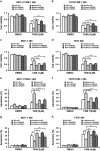Downregulation of microRNA-27b-3p enhances tamoxifen resistance in breast cancer by increasing NR5A2 and CREB1 expression
- PMID: 27809310
- PMCID: PMC5260890
- DOI: 10.1038/cddis.2016.361
Downregulation of microRNA-27b-3p enhances tamoxifen resistance in breast cancer by increasing NR5A2 and CREB1 expression
Abstract
Estrogen-dependent breast cancer is often treated with the aromatase inhibitors or estrogen receptor (ER) antagonists. Tamoxifen as a major ER antagonist is usually used to treat those patients with ERα-positive breast cancer. However, a majority of patients with ERα positive fail to respond to tamoxifen due to the presence of intrinsic or acquired resistance to the drug. Altered expression and functions of microRNAs (miRNAs) have been reportedly associated with tamoxifen resistance. In this study, we investigated the role of miR-27b-3p in resistance of breast cancer to tamoxifen. MiR-27b-3p levels were remarkably reduced in the tamoxifen-resistant breast cancer cells compared with their parental cells. In addition, miR-27b-3p was also significantly downregulated in breast tumor tissues relative to adjacent non-tumor tissues. Moreover, the expression levels of miR-27b-3p were lower in the breast cancer tissues from tamoxifen-resistant patients compared with that from untreated-tamoxifen patients. Notably, tamoxifen repressed miR-27b-3p expression, whereas estrogen induced miR-27b-3p expression in breast cancer cells. Besides, we provided experimental evidences that miR-27b-3p enhances the sensitivity of breast cancer cells to tamoxifen in vitro and in vivo models. More importantly, we validated that miR-27b-3p directly targeted and inhibited the expression of nuclear receptor subfamily 5 group A member 2 (NR5A2) and cAMP-response element binding protein 1 (CREB1) and therefore augmented tamoxifen-induced cytotoxicity in breast cancer. Lastly, miR-27b-3p levels were found to be significantly negatively correlated with both NR5A2 and CREB1 levels in breast cancer tissues. Our findings provided further evidence that miR-27b-3p might be considered as a novel and potential target for the diagnosis and treatment of tamoxifen-resistant breast cancer.
Figures









Similar articles
-
Overexpression miR-24-3p repressed Bim expression to confer tamoxifen resistance in breast cancer.J Cell Biochem. 2019 Aug;120(8):12966-12976. doi: 10.1002/jcb.28568. Epub 2019 Apr 18. J Cell Biochem. 2019. PMID: 31001849
-
MiR-27b is epigenetically downregulated in tamoxifen resistant breast cancer cells due to promoter methylation and regulates tamoxifen sensitivity by targeting HMGB3.Biochem Biophys Res Commun. 2016 Sep 2;477(4):768-773. doi: 10.1016/j.bbrc.2016.06.133. Epub 2016 Jun 27. Biochem Biophys Res Commun. 2016. PMID: 27363334
-
Exosomes Mediated Transfer of Circ_UBE2D2 Enhances the Resistance of Breast Cancer to Tamoxifen by Binding to MiR-200a-3p.Med Sci Monit. 2020 Aug 5;26:e922253. doi: 10.12659/MSM.922253. Med Sci Monit. 2020. PMID: 32756532 Free PMC article.
-
MiR 221/222 as New Players in Tamoxifen Resistance.Curr Pharm Des. 2016;22(46):6946-6955. doi: 10.2174/1381612822666161102100211. Curr Pharm Des. 2016. PMID: 27809747 Review.
-
The Role of MicroRNAs in Diagnosis, Prognosis, Metastasis and Resistant Cases in Breast Cancer.Curr Pharm Des. 2017;23(12):1845-1859. doi: 10.2174/1381612822666161027120043. Curr Pharm Des. 2017. PMID: 28231756 Review.
Cited by
-
SRF Potentiates Colon Cancer Metastasis and Progression in a microRNA-214/PTK6-Dependent Manner.Cancer Manag Res. 2020 Jul 28;12:6477-6491. doi: 10.2147/CMAR.S257422. eCollection 2020. Cancer Manag Res. 2020. Retraction in: Cancer Manag Res. 2022 Sep 23;14:2869-2870. doi: 10.2147/CMAR.S390685. PMID: 32801887 Free PMC article. Retracted.
-
CREB1, a direct target of miR-122, promotes cell proliferation and invasion in bladder cancer.Oncol Lett. 2018 Sep;16(3):3842-3848. doi: 10.3892/ol.2018.9118. Epub 2018 Jul 10. Oncol Lett. 2018. PMID: 30127997 Free PMC article.
-
MicroRNA-34a suppresses the invasion and migration of colorectal cancer cells by enhancing EGR1 and inhibiting vimentin.Exp Ther Med. 2019 Oct;18(4):2459-2466. doi: 10.3892/etm.2019.7826. Epub 2019 Jul 30. Exp Ther Med. 2019. PMID: 31555358 Free PMC article.
-
Down Regulated Expression Levels of miR-27b and miR-451a as a Potential Biomarker for Triple Negative Breast Cancer Patients Undergoing TAC Chemotherapy.Asian Pac J Cancer Prev. 2022 Mar 1;23(3):1053-1059. doi: 10.31557/APJCP.2022.23.3.1053. Asian Pac J Cancer Prev. 2022. PMID: 35345380 Free PMC article.
-
miR-27b-3p inhibits proliferation and potentially reverses multi-chemoresistance by targeting CBLB/GRB2 in breast cancer cells.Cell Death Dis. 2018 Feb 7;9(2):188. doi: 10.1038/s41419-017-0211-4. Cell Death Dis. 2018. PMID: 29416005 Free PMC article.
References
Publication types
MeSH terms
Substances
LinkOut - more resources
Full Text Sources
Other Literature Sources
Medical
Research Materials

